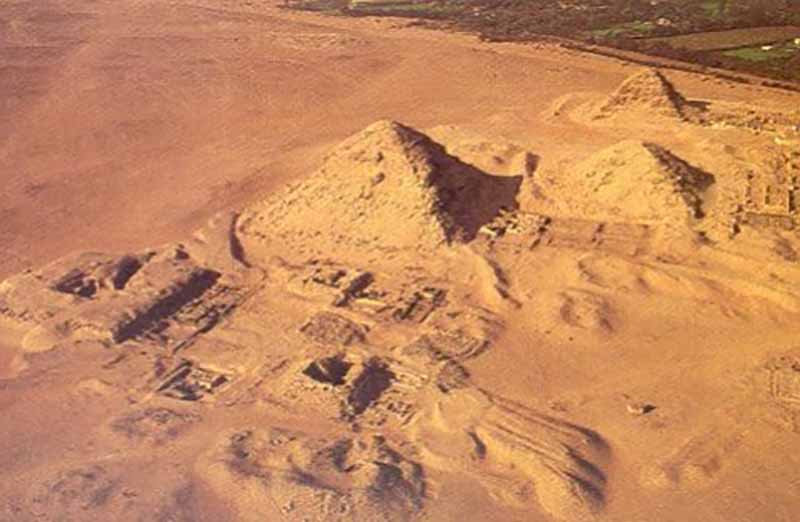
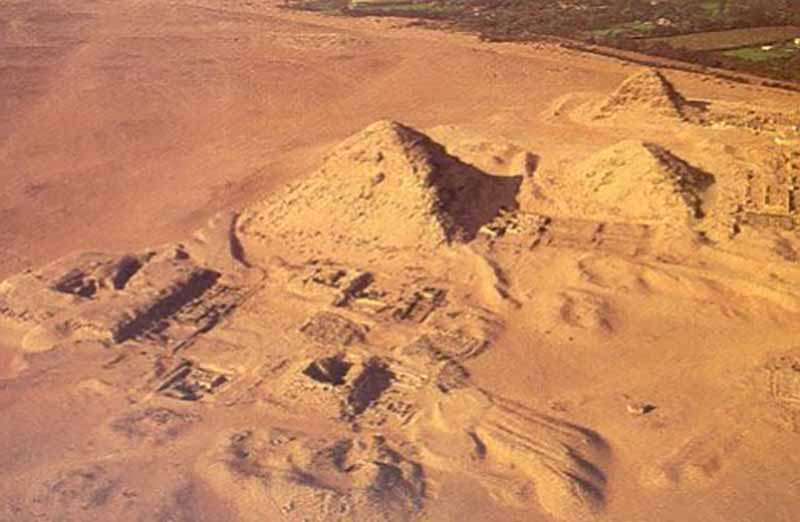
The pyramids at Mazghuna known as the Northern and Southern Mazghuna Pyramids, may belong to Sobeknefru (Queen Nefrusebek), the last pharaoh of Egypt's 12th Dynasty and Amenemhet IV, respectively, but no inscriptions bearing their names have been found and their ownership is far from certain. Mazghuna is a little known pyramid field about 5 kilometers (three or so miles) south of Dahshure. If these pyramids do belong to Sobeknefru and Amenemhet IV, they are evidence of the decline at the end of the 12th Dynasty of Egypt's Middle kingdom.
When the two Mazghuna pyramids were rediscovered, scholars noticed many structural similarities between those two and Amenemhat III's pyramid at Hawara; for this reason the southern pyramid was attributed to the son and successor of this king, Amenemhat IV. Subsequently, the northern pyramid was attributed to the female-pharaoh Sobekneferu, sister of Amenemhat IV and last ruler of the 12th Dynasty.
However, some scholars such as William C. Hayes believed that the two Mazghuna pyramids were built during the 13th Dynasty, on the basis of some similarities with the pyramid of Khendjer. In this case, the northern pyramid should have belonged to one of the many pharaohs who ruled between the beginning of the 13th Dynasty and the loss of control of the northern territory occurred during or after the reign of Merneferre Ay.


Originally, a causeway built with mudbrick walls lead to the northern pyramid.
The Northern Mazghuna Pyramid is the largest of the two ruins found in the Mazghuna field, though the pyramid core was never even begun, and the elaborate seal that led to the substructure entrance was never used. Because of the seal's resemblance to that used on the pyramid of Ameny-Qemau, is reason to believe this structure may date somewhat later then Egypt's 12th Dynasty.
The entrance to the pyramid was located on east side of the pyramid. Here, a short stairway descended to a square chamber. The underground corridor doubles back on itself in a U shape prior to arriving at the burial chamber, suggesting the structure of other Late Middle Kingdom pyramids found at South Saqqara. In the square chamber at the bottom of the entry stairway, a passage stairway descends at a right angle sloping down to the first portcullis chamber. The 42 ton quartzite plug lies in a recess to this chamber's north. All of its exposed area was painted red, as was ever other quartzite component within the substructure It would have slid into the chamber over a quartzite slab forming a wall, but was never closed. The corridors continue past this area with right angle turns past a second barrier chamber chamber similar to the first, before arriving at an antechamber to the north of the burial chamber.
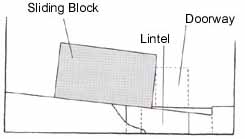
The burial chamber was filled with a monolithic quartzite sarcophagus vault, with a receptacle for the coffin in its north and the canopic receptacle in its south side. The lid to the sarcophagus was never put in place. It remained in a low chamber, waiting to be slid over the top of the vault and locked by a slab pushed over from a side recess. The exposed part of the quartzite sarcophagus was covered in plaster, and like elsewhere in the pyramid, painted red. On this painted surface are found patterns of vertical black strokes bounded by fine horizontal lines.
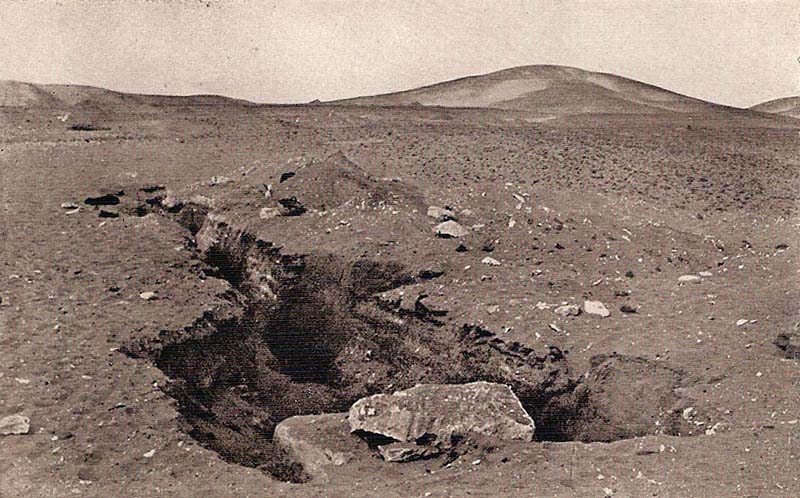
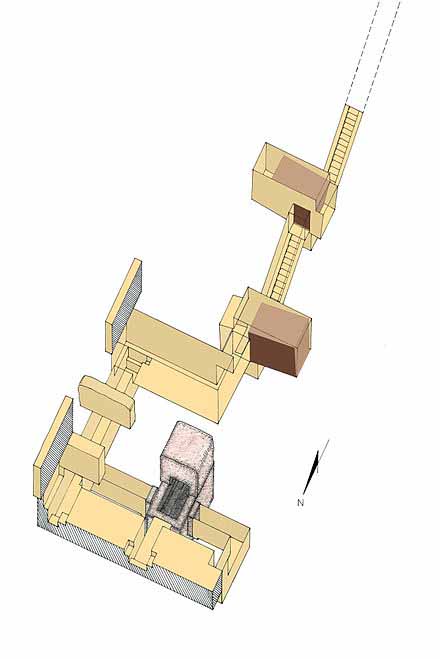
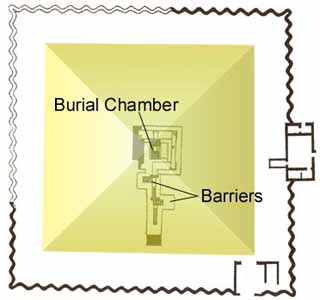
The pyramid has a side length of 52.5 m (172 ft). The core masonry consists of mudbricks and only reaches a height of one to two layers. Casing stones were not found; therefore, it is impossible to determine information about the planned inclination angle and total height.
The entrance of the pyramid is located in the middle of the south side. A staircase leads down to a short horizontal passage. Here is a wall niche, from where a blocking stone had been pushed into the passage. Another staircase leads to a second block, which, however, is still in its niche. Finally a U-shaped chamber system leads to the burial chamber, which is topped by a gable roof. There was an empty Ð but used Ð quartzite sarcophagus and some few grave goods (three limestone lamps, an alabaster duck-shaped vessel, a make-up vessel made from the same material and a piece of polished soapstone) were found in it.
The complex is surrounded by a wavy wall, which incorporate the remains of the chapel in the middle of the east side; it consists of a large central chamber with two chambers on each side of the storehouse. The central chamber was attached in its southwestern corner with a sacrificial hall with a vaulted roof.
The southern pyramid was investigated by a British archaeologist named Ernest MacKay in 1910. The complex was surrounded by a wavy enclosure wall of the type we typically see at the beginning of the early Middle Kingdom. The broad entrance in the wall is a vestibule built into the far east end of its south side. The area about this entrance was covered in limestone chips. Along the center of the eastern part of the enclosure wall was a mudbrick mortuary temple, really nothing more then a chapel that consisted of a large central chamber, or court, and several storage annexes to either side of the chamber. Attached to the rear, or southwest corner of the central chamber was an offering hall, which oddly, did not abut the pyramid.
The pyramid substructure, though complex, was never completed. Apparently only one or two courses of brick were laid to form the core of this pyramid, and a trench was dug around the outer edge in typical Middle Kingdom fashion to hold the casing securely in place. However, no casing stones have ever been found.
The entrance to the pyramid is in the middle of its south side. It opens into a stairway with shallow steps and side ramps that slope down to become level. At this transition is found the first barrier, consisting of a great portcullis block. The lower part of the passage is blocked by a granite slab, so that when the plug was slid into place from its recess, it blocked the continuation of the passage at the higher level. From this higher opening, another stairway ramp descended to a second block. This barrier is similar to the first, but the plug was left open. From here, corridors twisted around the eastern part of the burial chamber in three 90 degree turns before arriving at a service chamber for the burial chamber on its north side. This small service chamber had a trench dug to assist the introduction of funerary equipment into the burial chamber.
The burial chamber, located on the pyramid's vertical axis, itself is interesting. It probably had a ceiling reinforced by a saddle vault of limestone blocks. A single block of red quartzite fills its space. It constitutes an inner burial chamber similar to the chamber built for Amenemhet III in his vault at Hawara. This similarity, along with a similarity in the passages is what leads many Egyptologists to believe that this pyramid is attributable to Amenemhet IV. There are receptacles for the coffin and canopic hest cared into the block's interior. There was a lid to this inner burial chamber that featured two large slabs resting on the rim of the vault, with a gap left between them. Supports, resting on sand filled shafts, held the missing lid piece. Side channels allowed the sand to be removed, so that the missing lid piece would slip down into its slot.
Some grave goods were discovered in this pyramid. These included an alabaster vessel in the form of a trussed duck and three limestone lamps that were found in the small service chamber before the burial chamber, and a small alabaster kohl pot and a piece of glazed steatite left in the inner burial chamber.